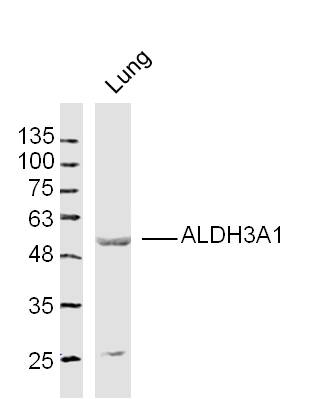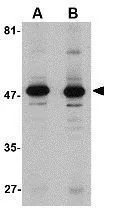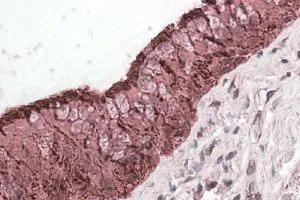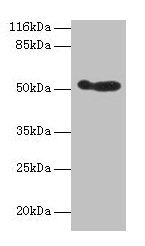ALDH3A1 antibody [N1C2]
GTX112391
ApplicationsWestern Blot, ImmunoHistoChemistry, ImmunoHistoChemistry Frozen
Product group Antibodies
TargetALDH3A1
Overview
- SupplierGeneTex
- Product NameALDH3A1 antibody [N1C2]
- Delivery Days Customer9
- Application Supplier NoteWB: 1:500-1:3000. IHC-Fr: 1:100-1:1000. *Optimal dilutions/concentrations should be determined by the researcher.Not tested in other applications.
- ApplicationsWestern Blot, ImmunoHistoChemistry, ImmunoHistoChemistry Frozen
- CertificationResearch Use Only
- ClonalityPolyclonal
- Concentration0.61 mg/ml
- ConjugateUnconjugated
- Gene ID218
- Target nameALDH3A1
- Target descriptionaldehyde dehydrogenase 3 family member A1
- Target synonymsALDH3, ALDHIII, aldehyde dehydrogenase, dimeric NADP-preferring, aldehyde dehydrogenase isozyme 3, aldehyde dehydrogenase type III, stomach aldehyde dehydrogenase
- HostRabbit
- IsotypeIgG
- Protein IDP30838
- Protein NameAldehyde dehydrogenase, dimeric NADP-preferring
- Scientific DescriptionAldehyde dehydrogenases oxidize various aldehydes to the corresponding acids. They are involved in the detoxification of alcohol-derived acetaldehyde and in the metabolism of corticosteroids, biogenic amines, neurotransmitters, and lipid peroxidation. The enzyme encoded by this gene forms a cytoplasmic homodimer that preferentially oxidizes aromatic and medium-chain (6 carbons or more) saturated and unsaturated aldehyde substrates. It is thought to promote resistance to UV and 4-hydroxy-2-nonenal-induced oxidative damage in the cornea. The gene is located within the Smith-Magenis syndrome region on chromosome 17. Multiple alternatively spliced variants, encoding the same protein, have been identified. [provided by RefSeq]
- Storage Instruction-20°C or -80°C,2°C to 8°C
- UNSPSC12352203
References
- Chen HY, Ho YJ, Chou HC, et al. TGF-β1 signaling protects retinal ganglion cells from oxidative stress via modulation of the HO-1/Nrf2 pathway. Chem Biol Interact. 2020,331:109249. doi: 10.1016/j.cbi.2020.109249Read this paper








